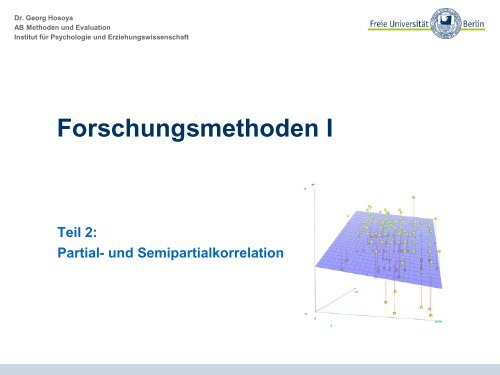2. Partial- und Semipartialkorrelation
You also want an ePaper? Increase the reach of your titles
YUMPU automatically turns print PDFs into web optimized ePapers that Google loves.
Dr. Georg Hosoya<br />
AB Methoden <strong>und</strong> Evaluation<br />
Institut für Psychologie <strong>und</strong> Erziehungswissenschaft<br />
Forschungsmethoden I<br />
Teil 2:<br />
<strong>Partial</strong>- <strong>und</strong> <strong>Semipartialkorrelation</strong>
<strong>Partial</strong>- <strong>und</strong> <strong>Semipartialkorrelation</strong><br />
• Indikationen<br />
• <strong>Partial</strong>korrelation<br />
• <strong>Semipartialkorrelation</strong><br />
Titel, Datum<br />
2
<strong>Partial</strong>- <strong>und</strong> <strong>Semipartialkorrelation</strong><br />
Indikationen:<br />
Aufdeckung red<strong>und</strong>anter Zusammenhänge<br />
Aufdeckung von Scheinkorrelationen bzw. Kontrolle von<br />
Störeinflüssen<br />
Aufdeckung maskierter Zusammenhänge<br />
Titel, Datum<br />
3
<strong>Partial</strong>- <strong>und</strong> <strong>Semipartialkorrelation</strong><br />
Hypothetisches Beispiel: Aufdecken von Scheinkorrelation durch<br />
<strong>Partial</strong>korrelation<br />
Sozioökonomischer Status<br />
Z<br />
(omitted confo<strong>und</strong>er,<br />
ausgelassene Drittvariable,<br />
Störvariable)<br />
Computernutzung<br />
X<br />
Positive Korrelation<br />
Y<br />
Schulerfolg<br />
Der positive Zusammenhang zwischen Computernutzung <strong>und</strong> Schulerfolg<br />
könnte darauf zurückzuführen sein, dass die drittvariable Z<br />
(sozioökonomischer Status) mit beiden Variablen korreliert.<br />
Titel, Datum<br />
4
<strong>Partial</strong>- <strong>und</strong> <strong>Semipartialkorrelation</strong><br />
Hypothetisches Beispiel: Aufdecken von Scheinkorrelation durch<br />
<strong>Partial</strong>korrelation<br />
Z<br />
Sozioökonimoscher Status<br />
(omitted confo<strong>und</strong>er,<br />
ausgelassene Drittvariable,<br />
Störvariable)<br />
Computernutzung<br />
X<br />
Y<br />
Schulerfolg<br />
Verschwindet der Zusammenhang, wenn der Einfluss von Z aus X <strong>und</strong> Y<br />
„herauspartialisiert“ wird, so handelt es sich um eine Scheinkorrelation.<br />
Titel, Datum<br />
5
<strong>Partial</strong>- <strong>und</strong> <strong>Semipartialkorrelation</strong><br />
<strong>Partial</strong>korrelation<br />
rr XXXXZZ = rr EEXX(ZZ) EE YY(ZZ)<br />
Z<br />
rr XXXXZZ =<br />
rr XXXX− rr XXZZ rr YYZZ<br />
1 − rr 2 2<br />
XXXX 1 − rr YYZZ<br />
X<br />
Y<br />
EE XX(ZZ)<br />
EE YY(ZZ)<br />
rr XXXXZZ<br />
Konzeptionell handelt es sich bei der <strong>Partial</strong>korrelation rr XXXXZZ um die<br />
Korrelation von Regressionsresiduen.<br />
Titel, Datum<br />
6
<strong>Partial</strong>- <strong>und</strong> <strong>Semipartialkorrelation</strong><br />
<strong>Semipartialkorrelation</strong><br />
rr YYZZ XX = rr EEYY(ZZ) XX<br />
Z<br />
rr (YYZZ)XX = rr XXXX−rr XXZZ rr YYZZ<br />
2<br />
1 − rr YYZZ<br />
X<br />
Y<br />
rr YYZZ XX<br />
EE YY(ZZ)<br />
Bei der <strong>Semipartialkorrelation</strong> wird die Drittvariable Z nur aus einer der beiden<br />
Variablen X <strong>und</strong> Y herauspartialisiert. (Systematische Varianz in Y, die auf Z<br />
zurückzuführen ist, wird eliminiert).<br />
Titel, Datum<br />
7
<strong>Partial</strong>- <strong>und</strong> <strong>Semipartialkorrelation</strong><br />
Beispiel<br />
Ist der Zusammenhang zwischen Lebenszufriedenheit (lz) <strong>und</strong> guter Stimmung<br />
(gz) darauf zurückzuführen, dass beide Variablen positiv mit der Persönlichkeits-<br />
Variablen Extraversion (extra) korrelieren?<br />
> cor(erstis_wm)<br />
lz gs extra<br />
lz 1.0000000 0.6254474 0.1979361<br />
gs 0.6254474 1.0000000 0.1806041<br />
extra 0.1979361 0.1806041 1.0000000<br />
> # Fälle mit missings auf mindestens einer der Variablen<br />
> # wurden aus dem Datensatz entfernt.<br />
Titel, Datum<br />
8
<strong>Partial</strong>- <strong>und</strong> <strong>Semipartialkorrelation</strong><br />
Beispiel: <strong>Partial</strong>korrelation mit R<br />
> library(ppcor)<br />
> pcor.test(erstis_wm$lz, erstis_wm$gs,<br />
erstis_wm$extra)<br />
estimate p.value statistic n gp Method<br />
1 0.6116603 7.284857e-26 10.51607 188 1 pearson<br />
Der Zusammenhang zwischen Lebenszufriedenheit (lz) <strong>und</strong> guter Stimmung<br />
(gs) bleibt bestehen, wenn Extraversion (extra) aus beiden Variablen<br />
herauspartialisiert wird <strong>und</strong> ist offenbar so gut wie nicht durch die Korrelation<br />
von Extraversion mit beiden Variablen bedingt.<br />
Titel, Datum<br />
9
<strong>Partial</strong>- <strong>und</strong> <strong>Semipartialkorrelation</strong><br />
Beispiel: <strong>Semipartialkorrelation</strong> mit R<br />
> spcor.test(erstis_wm$lz, erstis_wm$gs,<br />
erstis_wm$extra)<br />
estimate p.value statistic n gp Method<br />
1 0.5995585 <strong>2.</strong>211638e-24 10.18938 188 1 pearson<br />
Der Zusammenhang zwischen Lebenszufriedenheit (lz) <strong>und</strong> guter Stimmung<br />
(gs) bleibt bestehen, wenn Extraversion (extra) lediglich aus der Variablen<br />
gute Stimmung (gs) herauspartialisiert wird.<br />
Titel, Datum<br />
10
<strong>Partial</strong>- <strong>und</strong> <strong>Semipartialkorrelation</strong><br />
Lektüre:<br />
Eid, Gollwitzer <strong>und</strong> Schmitt (201*). Statistik <strong>und</strong> Forschungsmethoden.<br />
Kapitel 17 (bzw. Kapitel 18 in der Auflage von 2015).<br />
Titel, Datum<br />
11



